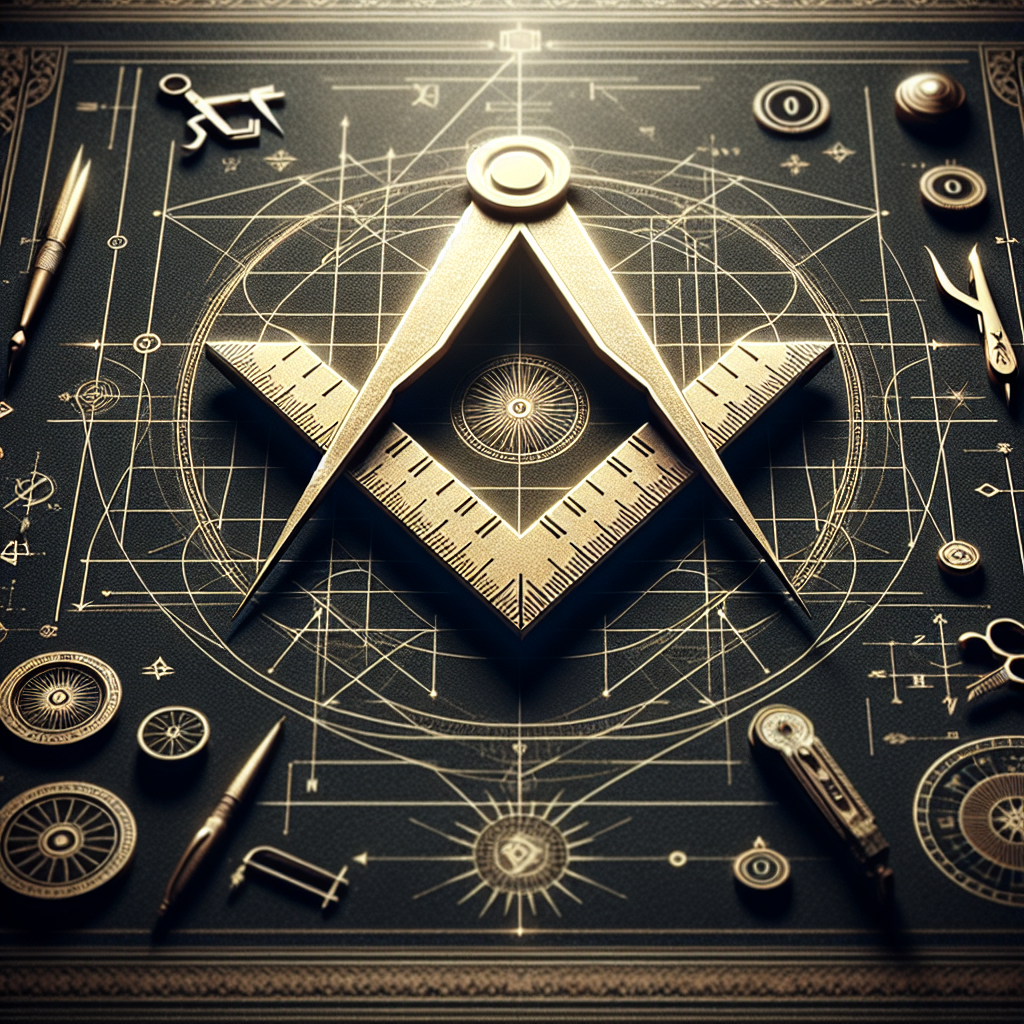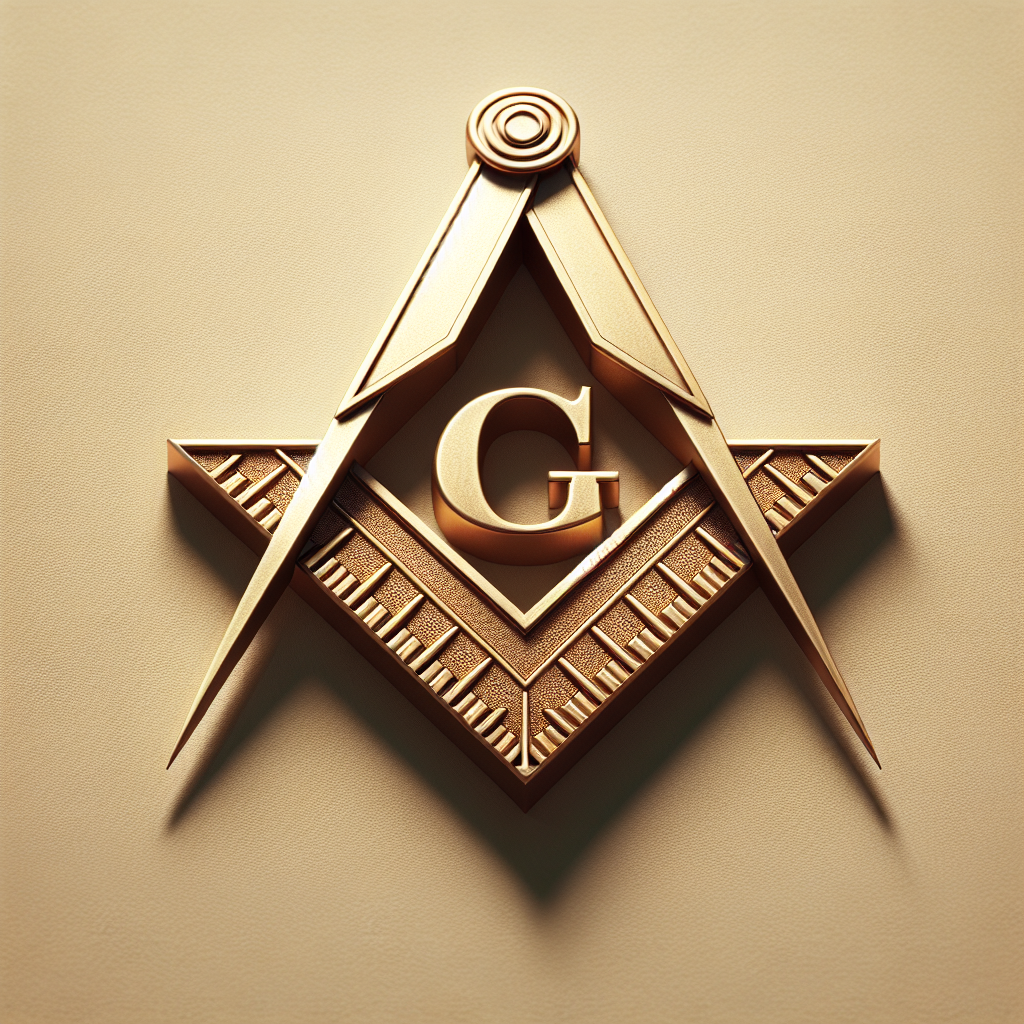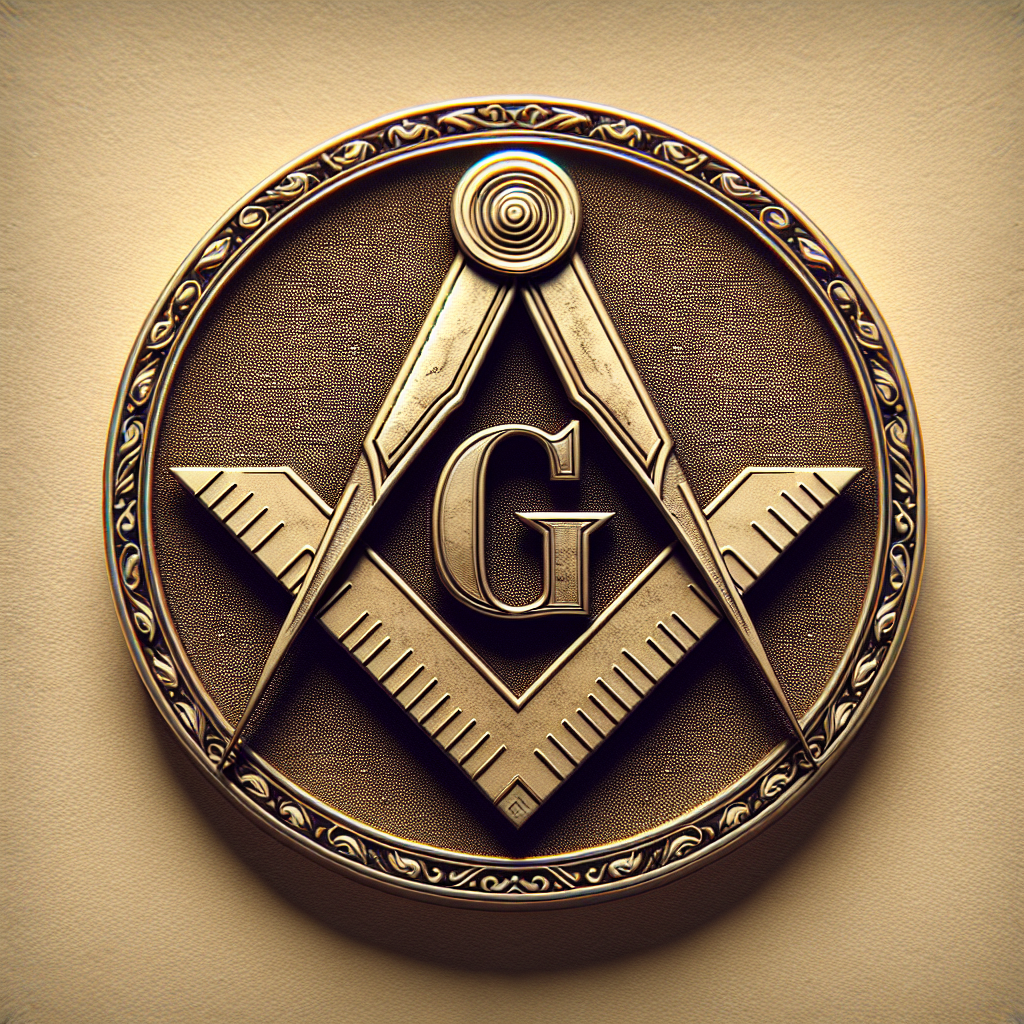
Have you ever wondered about the meaning behind the enigmatic Masonic symbol? This article “What Does the Masonic symbol Mean” is a fascinating exploration into the layers of symbolism and history that lie within this well-recognized emblem.
You’ll explore various interpretations and historical origins of the Masonic symbol, shedding light on the deep significance it holds within Freemasonry.
The mysteries that have intrigued so many about freemasons may well be concealed in this very symbol. So, prepare for your curiosity to be satiated as this article unveils the secrets of the Masonic symbol to you!
The Origin of Masonic Symbols
In Freemasonry, symbols are not just decorative elements; they serve as powerful tools for imparting wisdom, guiding members in their moral and philosophical journey. These symbols, steeped in history and meaning, provide insight into the core values of the fraternity and connect members to a tradition that spans centuries.
Historical Context of Masonic Symbolism
Freemasonry, often described as a fraternity of secrets and traditions, has long relied on symbolism to communicate its teachings and values.
The use of symbols in Freemasonry is thought to have originated as a means of conveying complex ideas in a way that transcends language barriers. Many of these symbols can be traced back to ancient civilizations, with influences from Egyptian, Greek, and medieval European cultures.
Also read: How do I Become a Freemason? What You Need to Know…
Over time, Freemasons have adopted and adapted these symbols, embedding within them layers of meaning that reflect the fraternity’s ideals of brotherhood, integrity, and enlightenment.
Association of Masonic Symbols with Stonemasonry
A key aspect of Masonic symbolism lies in its deep connection to the tools and practices of medieval stonemasons.
Freemasonry, after all, takes its roots from the guilds of operative stonemasons who built the grand cathedrals and castles of Europe. The Square and Compass, perhaps the most iconic of Masonic symbols, originally represented the fundamental tools of a mason’s trade.
Today, they symbolize the ethical framework upon which Freemasons strive to build their character—teaching principles of fairness, morality, and self-discipline. Other symbols, such as the plumb line and level, serve as metaphors for uprightness and equality in one’s dealings with others.
Evolution of Masonic Symbols Over Time
Throughout history, Masonic symbols have evolved, taking on new interpretations and adaptations as Freemasonry spread across the world.
Different lodges and Grand Lodges have introduced their own variations, incorporating local cultural elements while maintaining the universal core principles. Despite the variations in design and usage, the essence of these symbols remains steadfast—representing the timeless pursuit of wisdom, unity, and personal growth that defines Freemasonry.
Understanding Masonic Symbols
To truly appreciate the depth of Freemasonry, one must delve into the symbolic language that encapsulates its teachings.
Masonic symbols serve as visual aids that remind members of their moral responsibilities and spiritual aspirations.
Purpose and Significance of Symbols in Freemasonry
Each Masonic symbol carries a specific meaning and purpose, often serving as a lesson in virtue, character, and ethical conduct.
These symbols help convey the fraternity’s teachings in a way that is easily remembered and reflected upon. Beyond their instructional purpose, they foster a sense of unity among members, creating a shared understanding that transcends cultural and linguistic differences.
Whether displayed in lodge rooms, regalia, or rituals, Masonic symbols act as constant reminders of the fraternity’s core tenets—Brotherly Love, Relief, and Truth.
The Common Masonic Symbols
Some Masonic symbols have become widely recognized even outside of the fraternity.
The Square and Compass, often accompanied by the letter “G,” symbolize morality and the pursuit of knowledge. The All-Seeing Eye represents divine providence and the ever-watchful presence of a higher power. The Pillars of Solomon signify strength and wisdom, reflecting the architectural and philosophical foundations of Freemasonry.
The Checkered Pavement, a pattern of black and white tiles, symbolizes the duality of life—good and evil, light and darkness.
The Less Known Masonic Symbols
Beyond the well-known symbols, Freemasonry holds a treasure trove of lesser-known emblems, each with its own profound meaning.
The Two-Headed Eagle, often associated with the Scottish Rite, symbolizes duality and spiritual evolution. The Lambskin Apron, worn by Masons during rituals, signifies purity and the commitment to a life of service.
Various lodges incorporate unique symbols, such as the Beehive, which represents industriousness and cooperation, or the Anchor and Ark, symbolizing hope and steadfastness in life’s journey.
By exploring both the familiar and the obscure aspects of Masonic symbolism, members and enthusiasts alike can gain a deeper understanding of the fraternity’s teachings and the timeless wisdom it offers.
The Square and Compass Symbol
The Square and Compass is arguably the most recognized symbol of Freemasonry.
Explanation of the Square and Compass
This symbol consists of a square and a compass intersecting each other. The square, traditionally used by stonemasons to measure right angles, is seen as a symbol of virtue. On the other hand, the compass, used to draw perfect circles, symbolizes boundaries and the importance of self-control.
The significance of the ‘G’ in the middle of the symbol
Often, the Square and Compass symbol also contains a letter ‘G’ at the center. The ‘G’ is usually understood to stand for ‘God,’ the Great Architect of the Universe. In a more philosophical sense, it can also stand for Geometry, which is seen as the noble science that allows man to understand the divine order of the universe.
Symbolic associations of the Square and Compass
The Square and Compass symbol is associated with values of integrity, honesty, and ethical behaviour. With the Square symbolizing righteousness and the Compass embodying restraint, Masons are consistently reminded of their obligations towards righteousness and ethical practice.
The All-Seeing Eye Symbol
The All-Seeing Eye is another potent symbol in Freemasonry.
Origin of the All-Seeing Eye symbol
This symbol has ancient roots, often associated with divine providence in various cultures. In Freemasonry, the All-Seeing Eye represents the omniscient and omnipresent nature of the Supreme Being.
Interpretations of the All-Seeing Eye
The All-Seeing Eye symbolizes God’s constant watch over humanity. It is a symbol of enlightenment and divine guidance in the seekers’ journey towards moral and spiritual wisdom.
Associations of the All-Seeing Eye in popular culture
In recent years, the All-Seeing Eye has found widespread recognition in pop culture, especially in conspiracy theories around secret societies. Despite these newer connotations, within Freemasonry, it continues to hold its ancient and profound meaning of divine watchfulness.

The Pillars of Solomon Symbol
Another significant symbol in Freemasonry is the Pillars of Solomon.
Origin and representation of the Pillars of Solomon
The symbolic pillars of Solomon’s Temple – Boaz and Jachin, are represented in Masonic lodges. Boaz symbolizes strength and stands for the pillar on the left, while Jachin represents establishment and is the pillar on the right.
Symbolic meanings of the Pillars of Solomon
In Freemasonry, the pillars symbolize the necessity of strength and stability in any noble endeavor. As twin pillars, they represent the dualism of the universe and the balance required for harmony and progress.
Variations of the Pillars of Solomon in different lodges
The representations of these pillars may vary across different Masonic lodges, but the symbol invariably underscores the need for strength and constancy in the face of life’s moral, spiritual, and intellectual challenges.
People also liked: Masonic Influence in America Through Strength, Leadership, and Community
The Checkered Pavement Symbol
The checkered pavement is a pervasive and understated symbol in Freemasonry.
Understanding the checkerboard design
The symbol consists of a checkerboard pattern of light and dark squares. This design is often represented on the floor of Masonic lodges.
Meaning and symbolization of the Checkered Pavement
It symbolizes the duality of human life and experience – good and evil, joy and sorrow, light and darkness. In essence, it serves as a visual reminder of the balance needed in life.
Associations of the Checkered Pavement in Masonic rituals
This symbol plays a significant role in Masonic rituals, where candidates proceed on the checkered pavement, symbolically signifying their journey of personal growth and enlightenment.

The Two-Headed Eagle Symbol
The Two-Headed Eagle is a less commonly known but important symbol in Freemasonry.
Origins of the Two-Headed Eagle
The symbol of the Two-Headed Eagle has been used in various cultures and societies throughout history. In Freemasonry, it is particularly associated with the Scottish Rite.
The symbolism of the crowns, keys, and sword
In Masonic illustrations, the Two-Headed Eagle is typically depicted holding a sword and a pair of keys, symbolizing power and the key to wisdom. The crowns represent dominion over both spiritual and temporal realms.
The Two-Headed Eagle in Scottish Rite Freemasonry
The Two-Headed Eagle symbolizes the dual nature and jurisdiction of the Scottish Rite Freemasonry. It encourages the quest for spiritual and intellectual enlightenment.
The Lambskin Apron Symbol
The Lambskin Apron is one of Freemasonry’s most symbolic and personal emblems.
Significance of the apron in Masonic Ritual
In Masonic ritual, the Lambskin Apron serves as a symbol of purity and innocence. It is first given to a Mason in the Entered Apprentice degree as a symbol of the purity of heart required to embark on the spiritual journey of Masonry.
Link between Lambskin Apron and Stonemasons
Historically, stonemasons wore aprons to protect themselves from flying debris while sculpting. This practicality was transformed into a symbolic gesture within Freemasonry, linking Masonic teachings of righteousness with the purity and unblemished integrity of lambskin.
Symbolism associated with the Lambskin Apron
The Lambskin Apron represents purity of life and actions. It serves as a daily reminder to lead lives of purity and share the wisdom one attains during his journey in Freemasonry.

Masonic Symbolism in Architecture
The symbols in Freemasonry are not only restricted to the lodge: they’ve made their way into architecture around the world.
Masonic influence on architecture styles
Freemasonry has significantly influenced architectural styles, particularly during medieval times when the fraternity included many working stonemasons. Many historical edifices bear the imprint of Masonic symbolism in their structure or ornamentation.
Examples of Masonic symbolism in global landmarks
Internationally, several landmarks, including the US Capitol building, incorporate Masonic symbols in their architectural design, reflecting both the fraternity’s influence and the Masonic backgrounds of some of the architects and builders involved.
Interpretation of Masonic symbols in architectural context
Interpreting Masonic symbols within an architectural context adds another layer to our understanding of these symbols. It provides insights into the dramatic ways these symbols are manifested outside the confines of the Masonic lodges.
You may also like: Are Freemasons the Oldest Fraternity in the World?
Understanding Masonic Rites Through Symbols
Masonic rites are filled with symbolism, every aspect holds a hidden or heartfelt meaning, forming a layered experience.
The role of symbols in Masonic rites
The profound use of symbols in Masonic rites serves a dual purpose. On one hand, they help convey moral and philosophical teachings, while on the other hand, they act as common denominators or universal language that binds Freemasons around the world.
Specific symbols used in different Masonic degrees
Different Masonic degrees have unique symbols associated with them. For example, the Entered Apprentice degree uses the rough and smooth ashlars, the Fellowcraft degree highlights the pillars, and the Master Mason degree incorporates the sprig of acacia.
Exploration of the symbolic journey from Entered Apprentice to Master Mason
The progression from Entered Apprentice to Master Mason is itself a symbolic journey. It reflects the Mason’s spiritual, moral, and intellectual growth as he moves from innocence (symbolized in the lambskin apron) to a more profound understanding of life’s complexities (symbolized in the checkered pavement) and eventually to an enlightened state (symbolized in the all-seeing eye).
In conclusion, the symbols used in Freemasonry are more than mere artistic designs. They encapsulate moral teachings, principles of conduct, and philosophical insights that guide members along their Masonic journey. By understanding their meanings, you can better appreciate the richness and depth of Freemasonry’s legacy.













